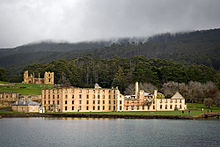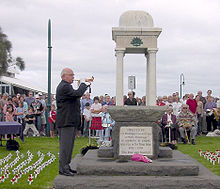The History of Australia refers to the history of the area and people of the Commonwealth of Australia and its preceding Indigenous and colonial societies. Aboriginal Australians are believed to have first arrived on the Australian mainland by sea from Maritime Southeast Asia between 40,000 and 70,000 years ago. The artistic, musical andspiritual traditions they established are among the longest surviving such traditions in human history.
The first known landing in Australia by Europeans was by Dutch navigator Willem Janszoon in 1606. Other Dutch navigators explored the western and southern coasts in the 17th century, and dubbed the continent New Holland. Macassan trepangers visited Australia's northern coasts after 1720, possibly earlier Other European explorers followed until, in 1770, Lieutenant James Cook charted the East Coast of Australia[4] for Britain and returned with accounts favouring colonisation at Botany Bay (now in Sydney), New South Wales.
A First Fleet of British ships arrived at Botany Bay in January 1788 to establish a penal colony. In the century that followed, the British established other colonies on the continent, and European explorersventured into its interior. Indigenous Australians were greatly weakened and their numbers diminished by introduced diseases and conflict with the colonists during this period.
Gold rushes and agricultural industries brought prosperity. Autonomous Parliamentary democracies began to be established throughout the six British colonies from the mid-19th century. The colonies voted by referendum to unite in a federation in 1901, and modern Australia came into being. Australia fought on the side of Britain in the two world wars and became a long-standing ally of the United States when threatened by Imperial Japan during World War II. Trade with Asia increased and a post-war multicultural immigration program received more than 6.5 million migrants from every continent. The population tripled in six decades to around 21 million in 2010, with people originating from 200 countries sustaining the world's 14th largest national economy..
Early explorers
Although a Theory of the Portuguese discovery of Australia in the 1520s exists, it lacks definitive evidence. The Dutch ship, Duyfken, led by Willem Janszoon, made the first documented European landing in Australia in 1606. That same year, a Spanish expedition sailing in nearby waters and led by Pedro Fernandez de Quiros had landed in the New Hebrides and, believing them to be the fabled southern continent, named the land: "Terra Austral del Espiritu Santo" (Southern Land of the Holy Spirit). Later that year, De Quiros' deputy Luís Vaez de Torressailed through Australia's Torres Strait and may have sighted Australia's northern coast.
The first recorded European sighting of the Australian mainland, and the first recorded European landfall on the Australian continent, are attributed to the Dutch navigator Willem Janszoon. He sighted the coast of Cape York Peninsula in early 1606, and made landfall on 26 February at the Pennefather River near the modern town of Weipa on Cape York. The Dutch charted the whole of the western and northern coastlines and named the island continent "New Holland" during the 17th century, but made no attempt at settlement. William Dampier, an English explorer and privateer, landed on the north-west coast of New Holland in 1688 and again in 1699 on a return trip. In 1770, James Cook sailed along and mapped the east coast, which he named New South Wales and claimed for Great Britain] With the loss of its American colonies in 1780, the British Government sent a fleet of ships, the "First Fleet", under the command of Captain Arthur Phillip, to establish a new penal colony in New South Wales. A camp was set up and the flag raised at Sydney Cove, Port Jackson, on 26 January 1788, a date which became Australia's national day, Australia Dayalthough the British Crown Colony of New South Wales was not formally promulgated until 7 February 1788. The first settlement led to the foundation of Sydney, the establishment of farming, industry and commerce; and the exploration and settlement of other regions.
A British settlement was established in Van Diemen's Land, now known as Tasmania, in 1803 and it became a separate colony in 1825. The United Kingdom formally claimed the western part of Western Australia (the Swan River Colony) in 1828 Separate colonies were carved from parts of New South Wales: South Australia in 1836, Victoria in 1851, and Queensland in 1859. The Northern Territory was founded in 1911 when it was excised from South Australia. South Australia was founded as a "free province"—it was never a penal colony. Victoria and Western Australia were also founded "free", but later accepted transported convicts. A campaign by the settlers of New South Wales led to the end of convict transportation to that colony; the last convict ship arrived in 1848.
The indigenous population, estimated to have been between 750,000 and 1,000,000 at the time European settlement began, declined for 150 years following settlement, mainly due to infectious disease.[59] A government policy of "assimilation" beginning with the Aboriginal Protection Act 1869 resulted in the removal of many Aboriginal children from their families and communities—often referred to as the Stolen Generations—a practice which may also have contributed to the decline in the indigenous population.The Federal government gained the power to make laws with respect to Aborigines following the 1967 referendum. Traditional ownership of land—aboriginal title—was not recognised until 1992, when the High Court case Mabo v Queensland (No 2) overturned the legal doctrine that Australia had been terra nullius ("land belonging to no one") before the European occupation.
A gold rush began in Australia in the early 1850] and the Eureka Rebellion against mining licence fees in 1854 was an early expression of civil disobedience. Between 1855 and 1890, the six colonies individually gained responsible government, managing most of their own affairs while remaining part of the British Empire. The Colonial Office in London retained control of some matters, notably foreign affairs]defence, and international shipping.
On 1 January 1901, federation of the colonies was achieved after a decade of planning, consultation and voting. The Commonwealth of Australia was established and it became adominion of the British Empire in 1907. The Federal Capital Territory (later renamed the Australian Capital Territory) was formed in 1911 as the location for the future federal capital of Canberra. Melbourne was the temporary seat of government from 1901 to 1927 while Canberra was being constructed.The Northern Territory was transferred from the control of the South Australian government to the federal parliament in 1911. In 1914, Australia joined Britain in fighting World War I, with support from both the outgoing Commonwealth Liberal Party and the incoming Australian Labor Party.Australians took part in many of the major battles fought on theWestern Front. Of about 416,000 who served, about 60,000 were killed and another 152,000 were wounded. Many Australians regard the defeat of the Australian and New Zealand Army Corps (ANZACs) at Gallipoli as the birth of the nation—its first major military action. The Kokoda Track campaign is regarded by many as an analogous nation-defining event during World War II.
Britain's Statute of Westminster 1931 formally ended most of the constitutional links between Australia and the UK. Australia adopted it in 1942, but it was backdated to 1939 to confirm the validity of legislation passed by the Australian Parliament during World War II. The shock of the United Kingdom's defeat in Asia in 1942 and the threat of Japanese invasion caused Australia to turn to the United States as a new ally and protector. Since 1951, Australia has been a formal military ally of the US, under the ANZUS treaty.After World War II Australia encouraged immigration from Europe. Since the 1970s and following the abolition of the White Australia policy, immigration from Asia and elsewhere was also promoted. As a result, Australia's demography, culture, and self-image were transformed. The final constitutional ties between Australia and the UK were severed with the passing of the Australia Act 1986, ending any British role in the government of the Australian States, and closing the option of judicial appeals to the Privy Councilin London. In a 1999 referendum, 55% of voters and a majority in every state rejected a proposal to become a republic with a president appointed by a two-thirds vote in both Houses of the Australian Parliament. Since the election of the Whitlam Government in 1972, there has been an increasing focus in foreign policy on ties with other Pacific Rim nations, while maintaining close ties with Australia's traditional allies and trading partners.



